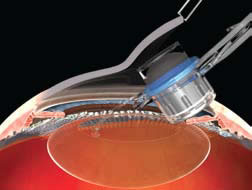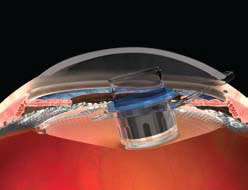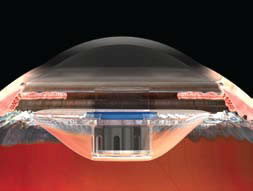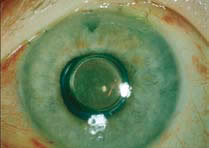The CentraSight miniature telescope is now being offered by Optegra in the UK. The implant was developed by Dr Charles Lipshitz in the US and is now being offered as part of a CenraSight treatment programme. This programme first offers a preoperative assessment.
Only patients with end-stage atrophic macular degeneration are suitable and also assessment by a low vision practitioner helps to ensure that the patient is likely to cope with the new visual environment once treatment has been undertaken.
The implant is a pea-sized telescopic system that is positioned within the capsule of the crystalline lens in such a way that it projects a three-times magnified image of the outside world on an area of retina outside the atrophic zone. This means that, in a way analogous to eccentric viewing, the patient has to relearn viewing using a peripheral area of retina which, although having a lower resolution to the fovea, should provide a significant improvement over a central scotoma.
Learning to use the unit correctly takes some adaptation time and so the postoperative care is essential to ensure adequate vision and acceptance.
A unique surgical technique that minimises capsular impact was developed to ensure the stability of the telescope.
The traumatic impact upon the eye and the capsule is minimal. However, there has been one reported case of a posterior capsular thickening after implantation. This was managed by a novel pars plana capsulotomy (Yag laser was considered too risky when an implant is in situ), which successfully removed the cause of cloudiness.
Several studies have confirmed that, with the right selection process, the implant can both improve visual acuity and also the quality of life for AMD sufferers. One such study looked at 217 patients and found that at the one-year mark, 67 per cent had achieved three lines or more better at both distance and near. Another study looked at progress after two years and found that the lens maintained the substantial improvement that had been gained from the implant.
The telescope, once fitted, represents an important improvement for patients, both in terms of vision and quality of life. The treatment is also cost effective. The lens represents a breakthrough in low vision rehabilitation and yet another opportunity for eye-care specialists to be involved in co-management programmes.
12mm limbal incision, 7mm capsulorrhexis |
|
Insertion |
|
Lead haptic in the capsular bag, |
|
Secured in capsular bag for centration |
|
Appearance of the eye with |






